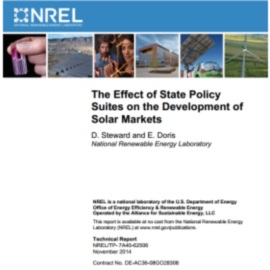
by Brianna Crandall — December 17, 2014—Facilities managers and owners who are determining whether solar power is a viable option in their area may be interested to know that analysts at the U.S. Department of Energy’s National Renewable Energy Laboratory (NREL) have used statistical analyses and detailed case studies to better understand why solar market policies in certain states are more successful. Their findings indicate that while no standard formula for solar implementation exists, a combination of foundational policies and localized strategies can increase solar photovoltaic (PV) installations in any state.
In the report, The Effect of State Policy Suites on the Development of Solar Markets, NREL researchers examined a variety of policy- and non-policy-based factors that influenced state and local solar markets. On the policy side, two factors strengthen a state’s solar market in all contexts: interconnection, or policies that define the procedural requirements for connecting a PV system to the electricity grid; and net metering, or policies that enable the utility to compensate individual PV system owners though a simple billing mechanism.
Non-policy issues that have implications for a solar market, such as the amount of sunlight available for potential solar generation, community interest in renewable energy, and the cost of competing grid electricity, were examined in the context of different states and local communities. The authors concluded that:
- States that have matched their suite of best-practice policies to their unique context have excelled.
- Both the number of solar policies and the length of time the policies have been in place are important indicators of market success.
- Support for solar leasing and other increasingly popular third-party ownership models seems to be a distinguishing factor in the success of solar markets in some states—but usually economic factors must also be favorable.
“We built quantitative evidence showing that, across the board, states with three or more market creation or market enabling policies have the most robust solar markets,” said the report’s coauthor Elizabeth Doris, a technical manager for Policy and Technical Assistance at NREL. “This study provides additional insight into how policies should be considered in light of non-policy factors to best support solar market development.”
The findings indicate that, while the age and composition of policy suites are important market foundations, solar policies are more effective when tailored to the economic and demographic background of the state. The report also includes case studies to better understand states that experience lagging solar markets despite having similar best practice policies as states with thriving solar markets. A fact sheet, animated graphic, and other resources summarizing the report’s major findings are available at NREL’s State and Local Governments Web site.
Supported by the Energy Department’s SunShot Initiative, this report is the third in a series of analyses that attempt to determine the relationship between demographic and economic contexts, state policies, and distributed solar installed capacity.
Related reports include: The Effectiveness of State-Level Policies on Solar Market Development in Different State Contexts, which found that extreme values of non-policy factors-including personal economic context, solar resource, competing electricity prices, and interest in sustainability-impact solar installation rates, and Strategic Sequencing for State Distributed PV Policies: A Quantitative Analysis of Policy Impacts and Interactions, which found that nonfinancial incentive policies and population can explain 70 percent of PV capacity growth.





